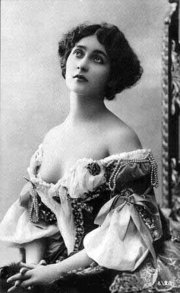Lina Cavalieri
|
|
Lina Cavalieri (December 25, 1874 - February 7, 1944) was an Italian operatic soprano known for her great beauty.
Born Natalina Cavalieri in Viterbo, Latium, Italy, she lost her parents at the age of fifteen and became a ward of the state, sent to live in a Roman Catholic orphanage. The vivacious young girl was extremely unhappy under the strict raising of the nuns and at the first opportunity she ran away with a touring theatrical group.
Blessed with a good singing voice, a young Lina Cavalieri made her way to Paris, France where her stunning good looks opened doors and she obtained work as a singer at one of the city's café-concerts. From there she performed at a variety of music halls and other such venues around Europe while still working to develop her voice for the opera. A soprano, Cavalieri took voice lessons and made her opera debut in Lisbon, Portugal in 1900, the same year she married her first husband, the Russian "Prince" Bariatonsky. Eventually she followed in the footsteps of Ericlea Darclée as one of the first stars of Puccini's Tosca. In 1904 she sang at the Opera de Monte Carlo then in 1905, at the Sarah Bernhardt Theatre in Paris, Cavalieri starred opposite Enrico Caruso in the Umberto Giordano opera, Fedora. From there, she and Caruso took the show to New York City, debuting with it at the Metropolitan Opera on December 5, 1906.
Cavalieri-hoop.jpg
Lina Cavalieri remained with the Metropolitan Opera for the next two seasons performing again with Caruso in 1907 in Puccini's Manon Lescaut. Renowned as much for her great beauty as for her singing voice, she became one of the most photographed stars of her time. Frequently referred to as the "world's most beautiful woman," she was part of the tightlacing tradition that saw women use corsetry to create an "hourglass" figure. During the 1909-1910 season she sang with Oscar Hammerstein's Manhattan Opera Company. Her first marriage long over, she had a whirlwind romance and marriage with Winthrop Astor Chandler (1863-1926), a member of New York's prominent Astor family. However, this marriage lasted only a very short time and Cavalieri returned to Europe where she became a much-loved star in pre-Revolutionary St. Petersburg, Russia and in the Ukraine.
During her successful career, Lina Cavalieri sang with other opera greats such as the Italian baritone Titta Ruffo and the French tenor Lucien Muratore, whom she married in 1913. After retiring from the stage, Cavalieri ran a cosmetic salon in Paris. In 1914, on the eve of her fortieth birthday, and still a very youthful looking and beautiful woman, she wrote an advice column on make up for women in Femina magazine and published a book, "My Secrets of Beauty." In 1915 she returned to her native Italy to make motion pictures. When that country became involved in World War I she went to the United States where she made four more silent films. The last three of her films were the product of her friend, the Belgian film director Edward José.
Married for the fourth time to Paolo d’Arvanni, Cavalieri returned to live with her husband in Italy. Well into her sixties when World War II broke out, she nevertheless worked as a volunteer nurse. Lina Cavalieri was killed in 1944 during an Allied bombing raid that destroyed her home in the outskirts of Florence, Italy.
In 1955, Italian actress Gina Lollobrigida portrayed Cavalieri in the film The World's Most Beautiful Woman. In 2004, a book was published authored by Paul Fryer and Olga Usova titled Lina Cavalieri -The Life of Opera’s Greatest Beauty, 1874-1944.
Filmography:
- The Two Brides (1919)
- A Woman of Impulse (1918)
- Love's Conquest (1918)
- The Eternal Temptress (1917)
- La Rosa di Granada (1916)
- La Sposa della morte (1915)
- Manon Lescaut (1914)

